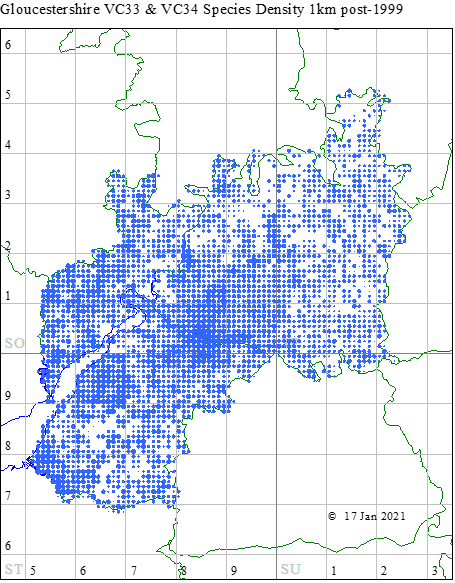2020 County Report for West Gloucestershire
Clive Lovatt
VC34 West Gloucestershire Annual Report to BSBI - 2020
Due to Covid-19 restrictions neither the Gloucestershire Naturalists’ Society nor its Bristol equivalent could offer any field meetings in 2020 (2019, 13) and the more active recorders met only on a few occasions.
26,870 records were added to the BSBI database for 2020 (2019, 34,905) but this was still our third highest annual number in the last 20 years. My predecessors as BSBI VC recorder Clare and Mark Kitchen, were particularly active, with 18,542 records, of which 16,608 were within their home hectad ST69, which they had not explored so thoroughly this century. The impact can be seen on the coverage maps below. Particularly interesting to the writer was their find of the increasingly elusive Pyrus pyraster, Wild Pear, on the outskirts of Thornbury (ST6590), its historic centre in our vice-county. It used to be known as Choke-pigs nearby, after the Choke Pears in Gerard’s Herbal.
At the request of Clive Stace, we also re-surveyed the county distribution of × Elyhordeum langei (Elymus athericus × Hordeum secalinum). Most of the world population is in VC34. At one of the sites (Cake Pill Gout, ST58) we found Atriplex glabriuscula × A. longipes, new to the county, and Alopecurus bulbosus × A. geniculatus, for which we had few records.
The most surprising find of the year was a new vice-county site for Stachys alpina, the Limestone Woundwort. It was discovered by David Hawkins of Bristol on the vice county boundary over 20km from Wotton-under-Edge, where it had been found new to Britain in the late 19th Century. We hope to write up an account for BSBI News later in 2021.
My own home area of Stroud, SO80 is already well-covered in the field and following the completion of Atlas2020 recording I worked indoors on my Historical Flora of the Avon Gorge (now 282 pages of draft typescript). I spent some time compiling the county rare plant register list, and now just need to deal with the provisional status column of the spreadsheet and write an introduction before it can be reviewed and released. It has a format and scope similar to the Somerset list accessible on the Somerset Rare Plants Group website. Hopefully, it will guide field work and encourage research and writing for some years.
Tim Rich’s commissioned 59-page illustrated ‘Key to hawkweeds Hieracium in Gloucestershire (vice-counties 33 and 34)’ was issued locally in time for this year’s flowering season, and several of us made collections mostly close to home for expert identification. When possible, we will have a local workshop, and hope to progress towards a better understanding of the local species than there has been for several generations of Gloucestershire botanists.
The annual lists of worthy Gloucestershire plant records for 2018 and 2019, written by Clare and Mark Kitchen and the undersigned were both published in 2020 in The Gloucestershire Naturalist. Online copies normally appear two years after publication. The Bristol Naturalists’ Society Bulletin (10 issues) includes reports of the informal meetings held near Bristol in 2020, some new plant records, and notes on Bristol Botanists written by the undersigned.
Dr Clive M Lovatt, 17 January 2021
